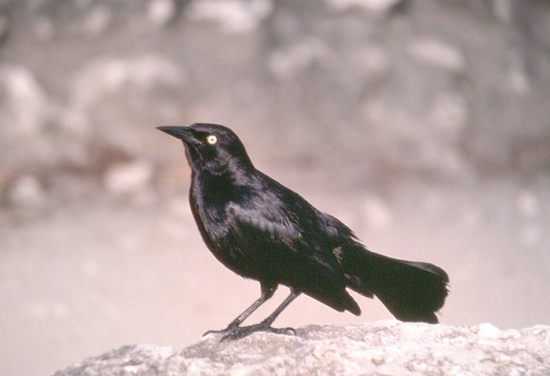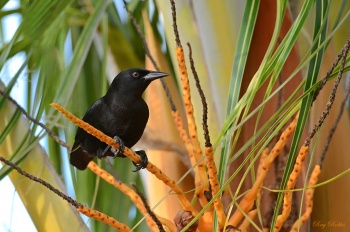- Quiscalus niger
Identification
25-30 cm
Adult male has yellow eyes and is glossy black with a deep V shape in the tail. Female duller and less strong V.
Juvenile even duller and with medium brown eyes.
Distribution
Greater Antilles: Cuba, Cayman Islands, Jamaica, Hispaniola, and Puerto Rico.
Taxonomy
Subspecies
Polytypic, Seven subspecies are recognized[1]:
- Q. n. caribaeus:
- Western Cuba, Isle of Pines and cays east to Cayos de las Doce Leguas
- Q. n. gundlachii:
- Central and easter Cuba and inner cays of Jardines de la Reina
- Q. n. caymanensis:
- Q. n. bangsi:
- Little Cayman Island and Cayman Brac
- Q. n. crassirostris:
- Q. n. niger:
- Hispaniola, Gonâve, Tortue, Île-a-Vache and Beata islands
- Q. n. brachypterus:
- Puerto Rico and Vieques Island
Habitat
Pastures, farms, scrub, parking lots and other open and edge areas in lowlands.
Behaviour
Usually occur in flocks, and outside of breeding season may roost in vary large flocks often at electrical substations.
References
- Clements, J. F., T. S. Schulenberg, M. J. Iliff, D. Roberson, T. A. Fredericks, B. L. Sullivan, and C. L. Wood. 2014. The eBird/Clements checklist of birds of the world: Version 6.9., with updates to August 2014. Downloaded from http://www.birds.cornell.edu/clementschecklist/download/
- Raffaele et al. 1998. Birds of the West Indies. Christopher Helm, London. ISBN 0713649054
- Kirwan, GM, A Levesque, M Oberle, and CJ Sharpe. 2019. Birds of the West Indies. (Lynx and Birdlife International Field Guides) Barcalona, Lynx Editions. ISBN 978-84-16728-17-6
Recommended Citation
- BirdForum Opus contributors. (2025) Greater Antillean Grackle. In: BirdForum, the forum for wild birds and birding. Retrieved 30 April 2025 from https://www.birdforum.net/opus/Greater_Antillean_Grackle
External Links
GSearch checked for 2020 platform.1





